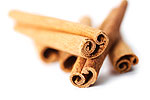 Cinnamon and components of cinnamon exert a beneficial effect on insulin sensitivity, glucose and fat metabolism while reducing inflammation, blood pressure and body weight. But the evidence for actually helping type 2 diabetics remains very questionable. Let’s take a look now.
Cinnamon and components of cinnamon exert a beneficial effect on insulin sensitivity, glucose and fat metabolism while reducing inflammation, blood pressure and body weight. But the evidence for actually helping type 2 diabetics remains very questionable. Let’s take a look now.
The evidence is as follows:
There is only one study where HbA1C (the hemoglobin measurement that gives an idea of one’s diabetic state) was lowered after cinnamon supplementation. Type 2 diabetic patients with HbA1C levels over seven percent were randomly assigned to: 1) typical usual care; or 2) typical care plus one gram daily of cinnamon capsules for 90 days. The results of this study show: cinnamon treatment lowered HbA1C by 0.83% (range: 0.46-1.20%), as compared with the typical care’s 0.37% (range: 0.15-0.59%).
In fact, there are five studies with type 2 diabetes that show cinnamon failing to lower HbA1C or cinnamon just lowered fasting blood glucose. Here is a look at them:
— 2003: A study tested one, three or six grams of cinnamon on 60 adults for 40 days. Cinnamon lowered fasting blood glucose by 18% to 29%, LDL cholesterol by seven percent to 27%, triglycerides by 23% to 30% and total cholesterol by 12% to 26%.
— 2006: A study tested 1.5 grams of cinnamon on 25 postmenopausal women with HbA1C levels between 7.1% and 7.4%. After six weeks, there was no change in HbA1C levels or cholesterol levels.
— 2006: A study tested three grams of cinnamon for four months on 79 patients. Cinnamon lowered fasting blood glucose 10.3% to placebo’s 3.4%. But there was no change in HbA1c levels or cholesterol.
— 72 adolescents with type 2 diabetes. There was no change in HbA1C levels.
— 2007: A study tested one gram of cinnamon for three months on 58 adults with HbA1C levels at 7.1%. There was no change in fasting blood glucose, cholesterol, or HbA1C levels.
The study that did find positive results gave these explanations for the conflicting results in the medical literature:
— Previous studies were conducted in patients with well-controlled diabetes.
— Some studies only measured fasting glucose without HbA1C.
— Some studies measured HbA1C too soon, namely after 30 days.
— Some studies had restricted age, sex or racial limitations.
— All studies excluded the use of insulin and co-morbid conditions.
— No studies allowed a change in medications.
If you attempt the cinnamon route, know that the usual dosage differs depending on what kind you use. Bark is two to four grams a day; essential oil is 0.05-0.2 ml diluted in carrier oil daily; fluid extract is 0.5-1 ml three times a day; and tincture is one to three ml three times a day.
The following adverse effects have been reported with cinnamon use: hypersensitivity; shortness of breath; anorexia; increased gut motility; gingivitis; stomach problems; flushing; and increased heart rate. Individuals with ulcer disease or intestinal problem should avoid using cinnamon.
Here are the previous articles in this series:
An Inside Look at Diabetes
How Effective Are Drugs for Diabetes?
The Ultimate Mineral for Diabetes
